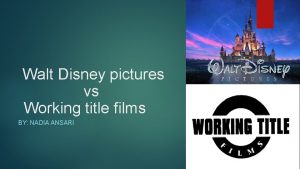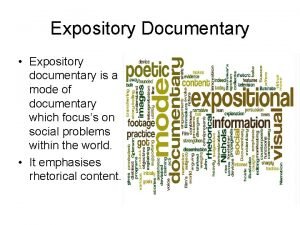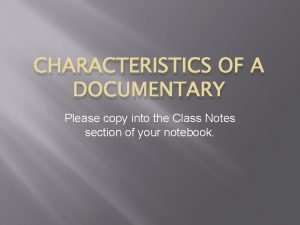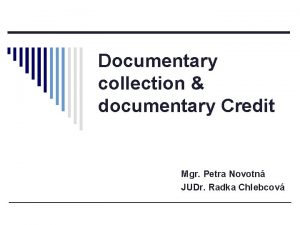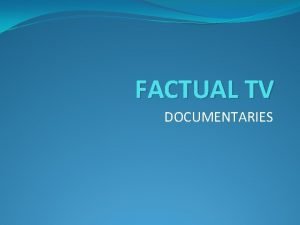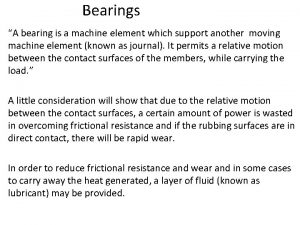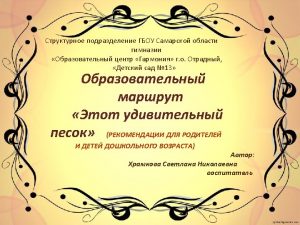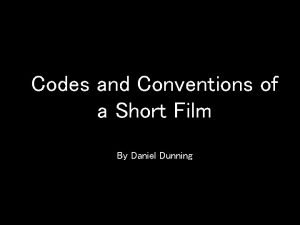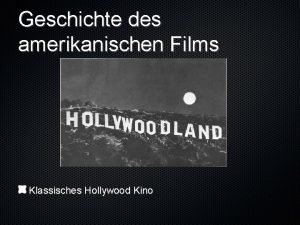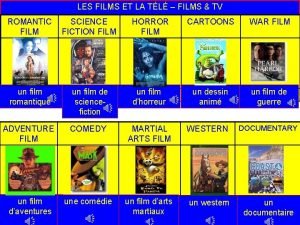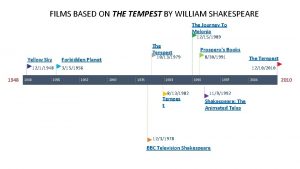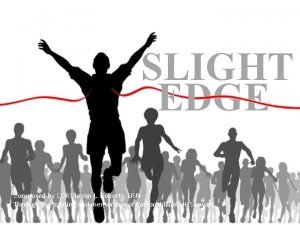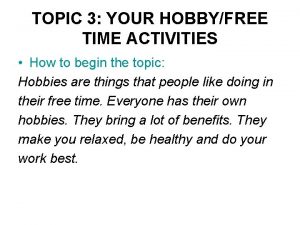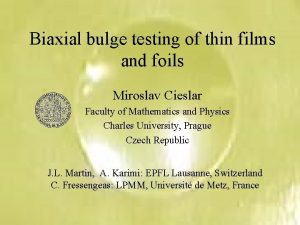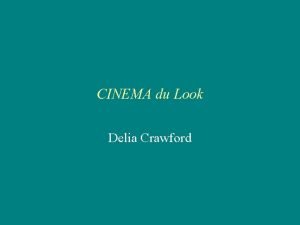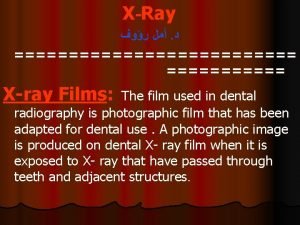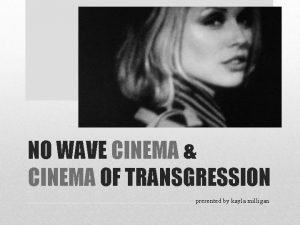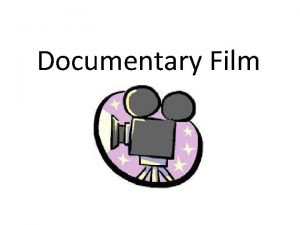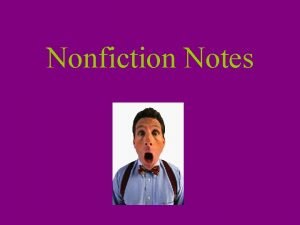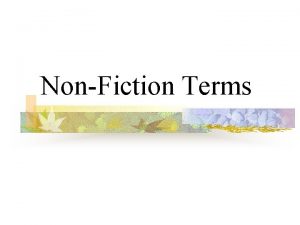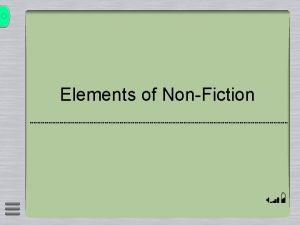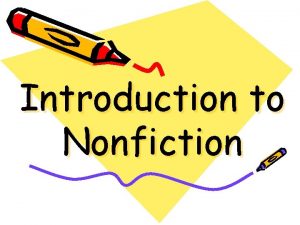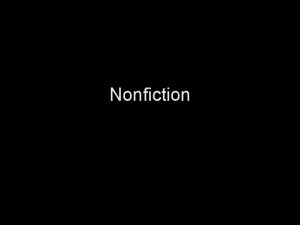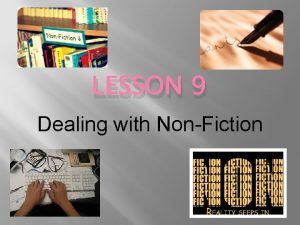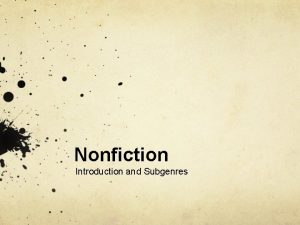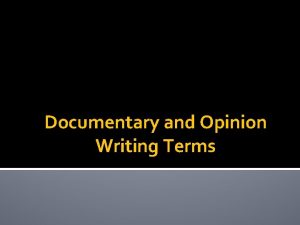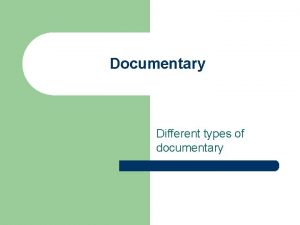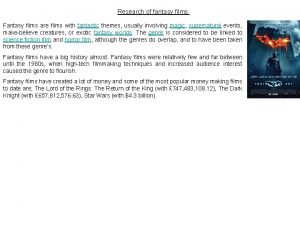DOCUMENTARY FILMS Documentary a nonfiction film or TV



















- Slides: 19

DOCUMENTARY FILMS Documentary: a non-fiction film or TV program which presents information, ideas or issues constructed for a variety of purposes. Documentaries focus on the real world and usually aim to instruct or to reveal some factual truth about it.

DOCUMENTARIES • Present ways of understanding the world, are based on real life • Explore human strengths and weaknesses • Seek the truth – instruct or reveal some truth about the real world. • Educate, inform, persuade and bring about social change • Use the familiar • Make claims about what has happened or is happening in the world outside the film • Construct an argument • Often aim to portray this factual reality as accurately as possible. • Use a series of conventions – sequence, structure, context, events and character development.

DOCUMENTARIES… • Are images captured on film and video and therefore are open to the same manipulation as other types of media. • How would you describe the manipulation which is used by the media? • We must not assume that documentaries always portray unbiased truth. Merely selecting a subject to be registered by the camera involves interpretation of some sort. • Documentaries are often carefully scripted and structured and despite their reliance on non-professional actors, spontaneous dialogue, or concealed cameras, they express a distinct – although sometimes subtle- perspective (POV).

STRUCTURE • Similar to fictional stories documentaries follow a certain pattern depending on their subject and purpose. the narrative structure of orientation, complication, crisis and resolution.

DISTINGUISHING A DOCUMENTARIES APPROACH… • Objective Documentaries - Known as “Direct Cinema” - Attempt to record events objectively w/o manipulation or direction. - The camera records life as it unfolds in real time. - Questions are not posed on screen, usually there is no narration, and often subjects do not know of the filmmaker’s presence. • Subjective Documentaries - Also known as opinionated documentaries - A distinct point of view is presented by the filmmaker. - Often the filmmaker narrates and participates either as a voice behind the camera or appearing as a character in front of the camera.

http: //www. highexistence. com/25 -documentaries-everybody-should -watch/ The Devil Came on Horseback is a documentary film by Ricki Stern and Anne Sundberg illustrating the continuing Darfur conflict in Sudan. Based on the book by former U. S. Marine Captain Brian Steidle and his experiences while working for the African Union. The film asks viewers to become educated about the on-going genocide in Darfur and laments the failure of the US and others to end the crisis. The World at War – (1973– 74) is a 26 -episode British television documentary series chronicling the events of the Second World War. https: //www. youtube. com/playlist? list=PL 66 B 78 D 5 DDAA 546 A 0

DOCUMENTARY FILM • There are six different types of Documentaries: • Poetic • Observational • Expository • Participatory • Reflexive • Performative

POETIC DOCUMENTARIES • This abstract approach to documentary filmmaking emphasizes visual associations, tonal or rhythmic qualities, description, and form. • Poetic documentaries first appeared in the 1920’s • Are abstract and artistic. Represent reality in a stylistic manner. Often, experimental film techniques are used to depict events in a metaphorical or symbolic way. • The poetic mode moved away from continuity editing and instead organized images of the material world by means of associations and patterns, both in terms of time and space. Well-rounded characters—’life-like people’—were absent; instead, people appeared in these films as entities, just like any other, that are found in the material world. • Examples: Night and Fog, Araya, General Orders No. 9.


OBSERVATIONAL DOCUMENTARIES • This mode uses the observations of an unobtrusive camera to create direct engagement with the everyday life of subjects. • Observational documentaries attempt to simply and spontaneously observe lived life with a minimum of intervention. • Often, there is no voice-over commentary, post-synchronized dialogue, sound track music, or re-enactments. The films aimed for immediacy, intimacy, and revelation of individual human character in ordinary life situations. The viewer simply is a ‘fly on the wall’. • The first observational docs date back to the 1960’s; the technological developments which made them possible include mobile lighweight cameras and portable sound recording equipment for synchronized sound. Often, this mode of film avoided voiceover commentary, post-synchronized dialogue and music, or re-enactments. The films aimed for immediacy, intimacy, and revelation of individual human character in ordinary life situations. • Examples: Primary, Titicut Follies, Gimme Shelter, The War Room, Metallica: Some Kind of Monster


EXPOSITORY DOCUMENTARIES The primary purpose of the Expository mode is to make an argument. • speak directly to the viewer, often in the form of an authoritative commentary employing voiceover or titles, proposing a strong argument and point of view. These films are rhetorical, and try to persuade the viewer. • The (voice-of-God) commentary often sounds ‘objective’ and omniscient. Images are often not paramount; they exist to advance the argument. • Examples: many science and nature documentaries History Channel documentaries, and older theatrical documentaries like The River, Night Mail, Spanish Earth, Nanook of the North.


PARTICIPATORY DOCUMENTARIES • This mode emphasizes the interaction between filmmaker and subjects. • believe that it is impossible for the act of filmmaking to not influence or alter the events being filmed. What these films do is emulate the approach of the anthropologist: participant-observation. Not only is the filmmaker part of the film, we also get a sense of how situations in the film are affected or altered by their presence. • Examples: the films of Wernor Herzog, Errol Morris, and Alex Gibney, Exit through the Gift Shop, Man on Wire, The Cove.


REFLEXIVE DOCUMENTARIES • This mode, which can include the mockumentary format, calls attention to the assumptions and conventions that govern documentary filmmaking to increase our awareness of how films construct representations of reality. • don’t see themselves as a transparent window on the world; instead they draw attention to their own ‘constructedness’, and the fact that they are representations. How does the world get represented by documentary films? • They prompt us to “question the authenticity of documentary in general. ” It is the most self-conscious of all the modes, and is highly skeptical of ‘realism. ’ It may use Brechtian alienation strategies to jar us, in order to ‘defamiliarize’ what we are seeing and how we are seeing it. • Vertov’s The Man with a Movie Camera (1929); Buñuel’s Land Without Bread; Trinh T. Minh-ha’s Surname Viet Given Name Nam (1989); Jim Mc. Bride & L. M. Kit Carson’s David Holzman’s Diary (1968); David & Judith Mac. Dougall’s Wedding Camels (1980).


PERFORMATIVE DOCUMENTARIES • highlights the subjective or expressive aspect of the filmmaker’s own involvement with a subject to heighten the audience’s responsiveness to the subject and to this involvement. • stress subjective experience and emotional response to the world. They are strongly personal, unconventional, perhaps poetic and/or experimental, and might include hypothetical enactments of events designed to make us experience what it might be like for us to possess a certain specific perspective on the world that is not our own • This sub-genre might also lend itself to certain groups (e. g. ethnic minorities) to ‘speak about themselves. ’ Often, a battery of techniques, many borrowed from fiction films, are used. Performative docs often link up personal accounts or experiences with larger political or historical realities. • Alain Resnais’ Night And Fog (1955), with a commentary by Holocaust survivior Jean Cayrol, is not a historical account of the Holocaust but instead a subjective account of it; it’s a film about memory. • Examples: : the films of Michael Moore, Tongues Untied, Chile Obstinate Memory, Waltz with Bashir, TV shows like Cops

THE REVELATION OF THE TRUTH • the role truth plays in documentaries and how the different forms presented show facts in very different ways.
 Who owns working title films
Who owns working title films Expository documentary mode
Expository documentary mode Characteristics of a documentary film
Characteristics of a documentary film Documentary collection definition
Documentary collection definition Documentary collection vs documentary credit
Documentary collection vs documentary credit Documentary conventions
Documentary conventions Wedge film journal bearing
Wedge film journal bearing Yandex.ru films
Yandex.ru films Conventions of short films
Conventions of short films Hollywood geschichte
Hollywood geschichte Single camera production
Single camera production Tl films
Tl films The tempest films
The tempest films In his course steven roberts uses original films with
In his course steven roberts uses original films with Watching movie hobby
Watching movie hobby Bulge test thin films
Bulge test thin films Cinema du look films
Cinema du look films The purpose of a lead foil sheet in the film packet is
The purpose of a lead foil sheet in the film packet is Opkoper dvd films
Opkoper dvd films No wave cinema
No wave cinema
